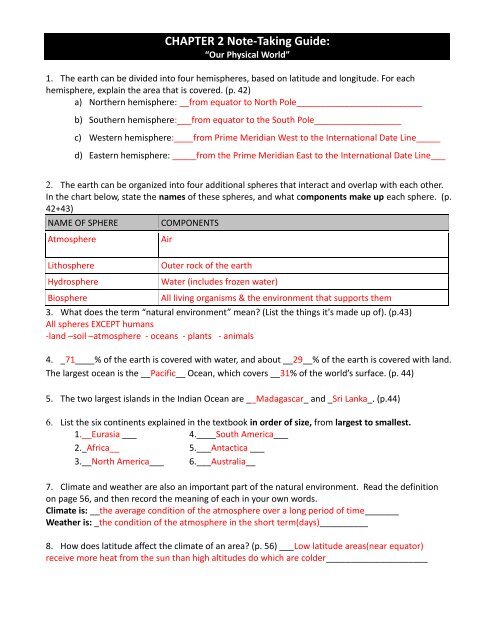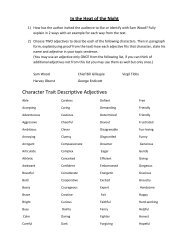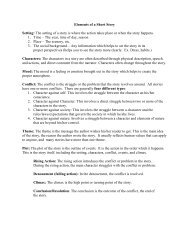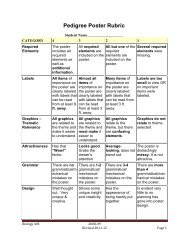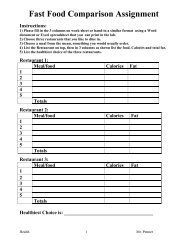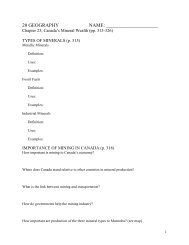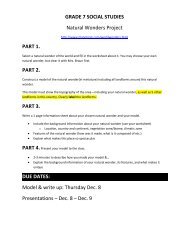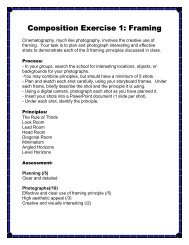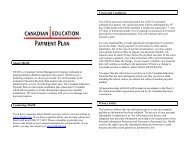CHAPTER 2 Note-Taking Guide:
CHAPTER 2 Note-Taking Guide:
CHAPTER 2 Note-Taking Guide:
You also want an ePaper? Increase the reach of your titles
YUMPU automatically turns print PDFs into web optimized ePapers that Google loves.
<strong>CHAPTER</strong> 2 <strong>Note</strong>-<strong>Taking</strong> <strong>Guide</strong>:<br />
“Our Physical World”<br />
1. The earth can be divided into four hemispheres, based on latitude and longitude. For each<br />
hemisphere, explain the area that is covered. (p. 42)<br />
a) Northern hemisphere: __from equator to North Pole__________________________<br />
b) Southern hemisphere:___from equator to the South Pole__________________<br />
c) Western hemisphere:____from Prime Meridian West to the International Date Line_____<br />
d) Eastern hemisphere: _____from the Prime Meridian East to the International Date Line___<br />
2. The earth can be organized into four additional spheres that interact and overlap with each other.<br />
In the chart below, state the names of these spheres, and what components make up each sphere. (p.<br />
42+43)<br />
NAME OF SPHERE COMPONENTS<br />
Atmosphere Air<br />
Lithosphere Outer rock of the earth<br />
Hydrosphere Water (includes frozen water)<br />
Biosphere All living organisms & the environment that supports them<br />
3. What does the term “natural environment” mean? (List the things it's made up of). (p.43)<br />
All spheres EXCEPT humans<br />
-land –soil –atmosphere - oceans - plants - animals<br />
4. _71____% of the earth is covered with water, and about __29__% of the earth is covered with land.<br />
The largest ocean is the __Pacific__ Ocean, which covers __31% of the world’s surface. (p. 44)<br />
5. The two largest islands in the Indian Ocean are __Madagascar_ and _Sri Lanka_. (p.44)<br />
6. List the six continents explained in the textbook in order of size, from largest to smallest.<br />
1.__Eurasia ___ 4.____South America___<br />
2._Africa__ 5.___Antactica ___<br />
3.__North America___ 6.___Australia__<br />
7. Climate and weather are also an important part of the natural environment. Read the definition<br />
on page 56, and then record the meaning of each in your own words.<br />
Climate is: __the average condition of the atmosphere over a long period of time_______<br />
Weather is: _the condition of the atmosphere in the short term(days)__________<br />
8. How does latitude affect the climate of an area? (p. 56) ___Low latitude areas(near equator)<br />
receive more heat from the sun than high altitudes do which are colder_____________________
9. The continents are always experiencing changes. Everything on the surface of the earth changes<br />
over time. Even landforms change slowly with time. There are 4 major types of landforms.<br />
List the four major types of landforms and give an explanation of each. (p. 50)<br />
NAME OF LANDFORM EXPLANATION<br />
Mountains<br />
Hills<br />
Plateaus<br />
Plains<br />
Irregular surfaces at high elevations<br />
Lower than mountains<br />
Large, flat areas at higher elevations than the land surrounding it<br />
Large regions of flat treeless land<br />
10. Fresh water is the most important resource on the earth. Without it, no life would exist. So,<br />
river and lakes are very important features of every continent. There are 6 reasons that people live<br />
near rivers. They are: (p.54+55)<br />
1) __provide food<br />
2) ___provide good farming soils and water for irrigation<br />
3) ___roadways, easy movement of people and goods<br />
4) ___recreation, allows for fun and relaxation<br />
5) They are a great source of power – hydro<br />
6) They are the best way to get around, especially in hard terrain<br />
11. According to the map on page 56, what type of climate region do we live in?<br />
_____humid/cold__________________________________<br />
12. The world is divided into five climate zones because of latitude, air masses, and pressure zones.<br />
What are the five factors that affect the area within each climate zone? (p. 57)<br />
-Ocean currents<br />
-Prevailing winds<br />
-Mountain barriers<br />
-Altitude<br />
-Distribution of sea and land (think about the difference between living in BC or MB)


